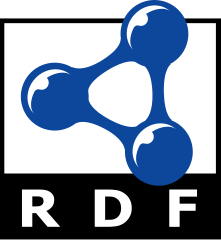
ARCHITECTURE OF SURVOL
 The
internal data model built by Survol, is based on RDF,
a standard model for data interchange in the Web. The data
representation of Survol is a RDF graph: a set
of triples: Subject, relation, object, and is also the core data type
found in the Semantic
web.
It is successfully used in Artificial Intelligence applications. This
abstract representation is independent of the display mode. The same set
of
data, extracted from an information system, is shown several ways:
The
internal data model built by Survol, is based on RDF,
a standard model for data interchange in the Web. The data
representation of Survol is a RDF graph: a set
of triples: Subject, relation, object, and is also the core data type
found in the Semantic
web.
It is successfully used in Artificial Intelligence applications. This
abstract representation is independent of the display mode. The same set
of
data, extracted from an information system, is shown several ways:| CIM_Process | This is the base class of a process, which is derived into Win32_Process |
| CIM_Datafile | A normal file: The concept and its implementation are similar in Windows and Linux. |
| CIM_Directory | File directories |
| Win32_UserAccount | A Windows user account. Linux has a specific definition, unrelated to this one. |
| Function |
What it does |
| EntityOntology |
This
returns an array of strings which are the name of the attributes of an
object of this class. This does not apply to domains. |
| Graphic_colorbg |
This
returns a RBG colour coded as a hexadecimal string. This colour is used
by any UI mode, for this class/domain, unless it is superseded by a
subclass or subdomain. |
| EntityName | This returns a
display name for
this object, given its attributes passed as an array, in the order
specified by the ontology. The hostname is also passed as an argument. The resulting
name does have to be unique, but must be printable. This applies to
classes only. |
| AddInfo | When displaying an
object, adds some extra information related to it. |
| Usable |
This tells if the
module or the
script, is usable in this context, given the platform, available
packages etc... It can be defined for any module or any script. |
| Resource | Account | Password | |
| Azure | |||
| Visual Studio Professional | 8532-42f4-a66a-c5da7acd | ||
| Login | |||
| DESKTOP-NI99V8E | johnwin | ||
| fedora22 | mary | ||
| MySql | |||
| sqlusertcsrvdb1.mysql.db | sqlusertcsrvdb1 | ||
| ODBC | |||
| MyOracleDataSource | system | ||
| Oracle | |||
| XE | scott | ||
| RabbitMQ | |||
| localhost:12345 | guest | ||
| SqlExpress | |||
| 192.168.0.14\SQLEXPRESS | jamessql | ||
| Survol | |||
| http://desktop-ni99v8e/Survol/survol/entity.py | |||
| http://win7-hp:8000/survol/entity.py | |||
| WBEM | |||
| http://192.168.0.17:5988 | pegasus | ||
| http://WIN7-HP:5988 | william | ||
| WMI | |||
| LAPTOP-B2HEHHF6 | user | ||